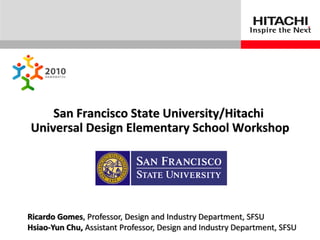Mais conteúdo relacionado Semelhante a Iaud ud hitachi.2010 (20) Mais de Design Center for Global Needs, San Francisco State University (9) 1. © Hitachi, Ltd. 2009. All rights reserved.
San Francisco State University/Hitachi
Universal Design Elementary School Workshop
Ricardo Gomes, Professor, Design and Industry Department, SFSU
Hsiao‐Yun Chu, Assistant Professor, Design and Industry Department, SFSU
6. © Hitachi, Ltd. 2009. All rights reserved.
Project Partnership
• Hitachi employee volunteers give UD lessons on universal design.
The SFSU/Hitachi study was based upon the Hitachi Corporate Responsibility
Program, that was created to teach elementary school students in Japan the
principles of Universal Design in 2005
• help children think more freely and creatively in expanding their
understanding about people‐friendly living spaces and communities.
7. © Hitachi, Ltd. 2009. All rights reserved.
Purpose
• Expanding Hitachi’s Corporate Social Responsibility efforts with its
Hitachi America offices to incorporate Universal Design educational
outreach into its community service outreach.
• The localized UD workshop materials used to train to serve as
facilitators for UD Elementary Educational workshops in the US.
34. Understandings
• establish an awareness for
the perspectives of people
living with disabilities.
• show the importance of
being considerate of other
people
• illustrate the concept that
things should be intuitive to
use and understand for
everyone
39. © Hitachi, Ltd. 2009. All rights reserved.
Conclusions
• What distinguished the collaborative Hitachi/SFSU partnership was the
unique balance of academic and professional expertise that benefited
from the diverse background and interdisciplinary abilities of faculty and
students
• By developing new workshop materials and refining them along the way
with expert feedback, we were able to successfully transition, localize and
test an educational module originally developed for Japanese students to
the US population.
• This experience benefited Hitachi in the area of corporate social
responsibility, provided opportunity for SFSU faculty and students to apply
their expertise in design and education through a valuable research and
community service learning experience
40. © Hitachi, Ltd. 2009. All rights reserved.
ACKNOWLEDGEMENT AND CREDITS:
Collaborative Project Contributors:
Hitachi Contributors
Mr. Kazuyuki Miyanaga, Senior Manager, Corporate Social Responsibility
Promotion Department, Hitachi, Ltd., Tokyo, Japan
Ms. Yukie Motomiya, Senior Designer, User Experience Research
Department, Hitachi, Ltd., Tokyo, Japan
Ms. Carol Kalé, Assistant Manager, Corporate Social Responsibility,
Hitachi America, Ltd., Brisbane, CA
San Francisco State University/Clarendon Elementary
41. © Hitachi, Ltd. 2009. All rights reserved.
ACKNOWLEDGEMENT AND CREDITS:
San Francisco State University/Clarendon Elementary
Collaborative Project Contributors:
Ms. Ikue Enomoto, Graduate Research Associate, Design & Industry
Department, SFSU
Mr. Hiroki Takeshita, Graduate Research Associate, Design & Industry
Department, SFSU
Ms. Diane Garfield, 5th Grade Teacher, Clarendon Elementary School, San
Francisco Unified School District (SFUSD)San Francisco,
Clarendon Elementary School, San Francisco Unified School District, SFUSD,
5th Grade Class, Ms. Diane Garfield, Teacher

